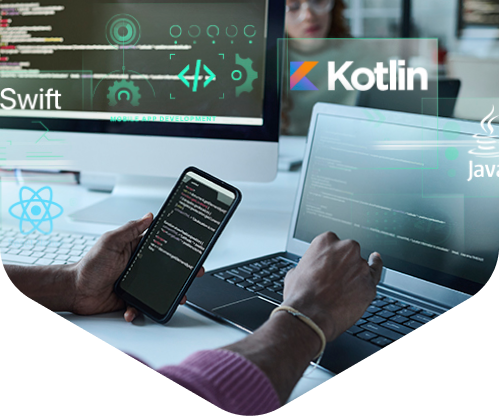Best Programming Languages for Mobile App Development
All mobile app development languages have different characteristics, strengths, and weaknesses that can significantly impact the development process and the app’s outcome.
As such, there’s no single best language for mobile app development. There are several frameworks and languages for app development to meet different use cases.
Choosing the right programming language can facilitate efficient coding, optimize app performance, streamline maintenance, and enable seamless integration with existing systems.
This article provides a comprehensive overview and comparison of the best programming languages for mobile app development.
Swift
Swift is a modern, open-source programming language developed by Apple for iOS, macOS, watchOS, and tvOS app development. It is designed to be safe, fast, and expressive, providing developers with a seamless mobile app programming experience.
Advantages
- Safety and performance: Swift eliminates common programming errors through features like optional types and automatic memory management, resulting in safer and more stable apps. It also boasts faster performance compared to Objective-C.
- Modern syntax: Swift’s syntax is concise, expressive, and user-friendly, making it easier to read and write code. This enhances developer productivity and reduces the likelihood of bugs.
- Active community and support: Swift has a thriving developer community, ensuring regular updates, ample documentation, and numerous open-source libraries and frameworks.
- Full-stack development: Swift can be used for both frontend (iOS/macOS apps) and backend development (with frameworks like Vapor), providing a unified development experience.
Disadvantages
- Platform limitations: Swift is primarily used for iOS, macOS, watchOS, and tvOS development, limiting its cross-platform capabilities. As such, it is not the best language for mobile app development outside of the Apple ecosystem.
- Learning curve: While Swift’s syntax is relatively easy to grasp, developers transitioning from other languages may need time to adapt to its unique features and concepts.
- Limited legacy support: Swift is one of the newer languages for app development, so it may lack extensive support for legacy systems and libraries compared to more established languages like Java.
Use Cases for Swift
Swift is excellent for developing native iOS, macOS, watchOS, and tvOS apps. Use cases for Swift-based mobile app development include:
- Consumer-facing apps: Swift enables the creation of visually appealing and user-friendly apps with smooth animations, gesture recognition, and seamless integration with Apple’s hardware features.
- Enterprise apps: Swift’s safety features and modern syntax make it suitable for building reliable and secure business apps that interact with backend systems and APIs.
- Gaming apps: Swift’s performance and access to Apple’s Metal framework make it ideal for developing immersive and graphically intensive gaming apps.
Java
Java is possibly the most versatile and widely used of all mobile app development languages. Java is known for its “write once, run anywhere” philosophy. Sun Microsystems developed it, and Oracle now maintains it. Java’s key features include its object-oriented nature, strong type checking, garbage collection, and extensive standard library.
Advantages
- Platform independence: Java’s “write once, run anywhere” capability allows developers to build applications that can run on various platforms, including Android, desktop, web, and embedded systems.
- Robustness and scalability: Java’s strong typing and exception handling provide a robust framework for building large-scale applications with minimal errors. It offers features like garbage collection for efficient memory management.
- Broad community support: Java has a massive developer community, providing access to abundant resources, libraries, and frameworks.
- Legacy compatibility: Java’s long-standing presence in the industry means it has extensive support for legacy systems and libraries, making it suitable for maintaining and enhancing existing applications.
Disadvantages
- Learning curve: Java has a steeper learning curve than other languages, primarily due to its object-oriented concepts and verbosity.
- Performance limitations: While Java offers solid performance, it may not match the speed of languages like Swift or Kotlin due to its bytecode interpretation. However, just-in-time (JIT) compilation techniques have improved Java’s performance.
- Heavy code: Java’s syntax can be complex, resulting in long lines of code compared to more concise languages.
Use Cases for Java
Some of the best use cases for Java-based mobile app development include:
- Android app development: Java is the primary programming language for Android, providing access to the vast Android SDK and a multitude of libraries and tools. It is suitable for developing a wide range of apps, from simple utility apps to complex enterprise solutions.
- Enterprise applications: Java’s enterprise capabilities, such as its support for multithreading, networking, and database connectivity, make it ideal for building scalable and reliable business applications.
- IoT and embedded systems: Java’s platform independence and resource efficiency make it suitable for developing applications for IoT devices and embedded systems.
Kotlin
Kotlin is a modern, statically-typed programming language developed by JetBrains. Kotlin is known for its seamless interoperability with Java. It is designed to be safe, concise, and interoperable, offering features such as null safety, extension functions, data classes, and co-routines for asynchronous programming.
Advantages
- Interoperability with Java: Kotlin is fully interoperable with Java, enabling developers to use existing Java libraries and frameworks seamlessly. This makes it a smooth transition for Java developers adopting Kotlin.
- Concise and expressive syntax: Kotlin’s syntax is more concise than Java, reducing boilerplate code and increasing developer productivity. It includes features like type inference, smart casts, and extension functions, allowing for cleaner and more readable code.
- Null safety: Kotlin includes null safety features that help eliminate null pointer exceptions, a common source of bugs in Java code. Nullable and non-nullable types are distinguished in the language, enhancing code reliability.
- Co-routines: Kotlin natively supports co-routines, which simplifies asynchronous programming by providing a lightweight and intuitive way to handle concurrency and asynchronous operations.
Disadvantages
- Learning curve: While Kotlin’s syntax is relatively easy to understand, developers transitioning from Java may need to learn new language features and concepts.
- Smaller community than Java: Although Kotlin’s community is growing rapidly, it is still smaller than Java’s. However, Kotlin benefits from the vast Java community and ecosystem, ensuring access to extensive resources and support.
Use Cases for Kotlin
Kotlin has gained significant popularity in Android app development due to its seamless Java interoperability and modern features. Some of the best use cases for Kotlin-based mobile app development include:
- Android app development: Kotlin is officially supported by Google for Android app development. It offers improved syntax, null safety, and other language features that enhance code readability, maintainability, and reliability.
- Modernization of existing Java codebases: Kotlin’s interoperability with Java allows developers to gradually introduce Kotlin into existing Java projects, modernizing the codebase and benefiting from Kotlin’s features without the need for a complete rewrite.
- Cross-platform mobile app development: Kotlin Multiplatform enables developers to share business logic and code across multiple platforms, including iOS, Android, and backend systems.
React Native
React Native, developed by Facebook, is a popular JavaScript framework that allows developers to build native mobile apps for iOS and Android using a single codebase. It utilizes JavaScript to create reusable UI components that are translated into native code at runtime.
Advantages
- Cross-platform development: React Native enables developers to write code once and deploy it on both iOS and Android platforms, saving time and resources. This cross-platform capability reduces the need for separate development teams for each platform.
- Reusability: React Native promotes code reusability, allowing developers to share a significant portion of the codebase between platforms. This streamlines development and maintenance efforts, as changes made to shared code automatically reflect on both platforms.
- Speed of development: JavaScript’s simplicity and React Native’s component-based architecture contribute to rapid development cycles. Hot reloading, a feature in React Native, allows developers to see instant code changes, making the development process more efficient.
- Large developer community and ecosystem: JavaScript has a vast and active developer community, providing access to many resources, libraries, and frameworks. React Native benefits from this ecosystem, ensuring continuous support, updates, and contributions.
Disadvantages
- Performance considerations: While React Native provides a native-like experience, it may not achieve the same performance as fully native apps built with Swift, Kotlin, or Java. Intensive graphics or complex animations might experience performance limitations in comparison with those application development languages.
- Platform limitations: Although React Native aims for cross-platform compatibility, certain platform-specific functionalities may require additional native coding or third-party libraries, adding complexity to the development process.
- Dependency on JavaScript runtime: React Native relies on JavaScript runtime for executing code, which may introduce slight overhead and affect performance compared to fully compiled languages.
Use Cases for React Native
React Native are well-suited for various types of mobile app development, including:
- Cross-platform app development: React Native is one of the more versatile mobile app development languages for cross-platform development, making it an excellent choice for apps targeting both iOS and Android platforms simultaneously.
- Prototyping and MVPs: JavaScript and React Native allow for rapid prototyping and building minimum viable products (MVPs) with minimal development effort. This is beneficial for startups or projects with limited resources and tight timelines.
- Apps with dynamic UIs: React Native’s component-based architecture and JavaScript’s flexibility make it ideal for apps with dynamic user interfaces, such as social media apps, e-commerce apps, and content-driven applications.
- Hybrid apps: React Native is suitable for hybrid app development, where web technologies are leveraged within a native app shell. This approach allows for easier code sharing between web and mobile applications.
Flutter
Flutter is an open-source UI toolkit developed by Google for building natively compiled mobile, web, and desktop applications from a single codebase. Flutter utilizes the Dart programming language, also developed by Google, as its primary language.
Advantages
- Cross-platform development: Flutter allows developers to write code once and deploy it on multiple platforms, including iOS, Android, web, and desktop. This reduces development time, effort, and the need for separate teams and codebases for each platform.
- Fast and customizable UI: Flutter offers a rich set of pre-built UI components called widgets, enabling developers to create visually appealing and highly customizable user interfaces. Flutter’s “hot reload” feature allows for real-time code changes, resulting in a faster development cycle.
- Performance: Flutter’s architecture and Dart’s just-in-time (JIT) compilation allow for efficient performance. The Flutter framework renders UI components using Skia, a high-performance graphics engine, resulting in smooth animations and a responsive user experience.
- Strong community and support: Flutter has a growing and enthusiastic community, providing ample resources, packages, and third-party libraries.
Disadvantages
- Learning curve: While Dart has a syntax similar to other popular languages, developers new to it may require some time to familiarize themselves with its features and concepts.
- Limited libraries and integrations: Compared to more established languages like Java or Swift, the Flutter ecosystem may have fewer libraries and integrations available.
Use Cases for Flutter
Flutter is well-suited for various mobile app development use cases, including:
- Cross-platform app development: Flutter’s ability to build apps for multiple platforms from a single codebase makes it ideal for projects that target iOS, Android, web, and desktop platforms simultaneously.
- UI-rich applications: Flutter’s customizable UI components and fast rendering engine make it suitable for developing apps with visually rich and complex user interfaces, such as social media apps, e-commerce apps, and media streaming applications.
- MVP and rapid prototyping: Flutter’s hot reload feature and efficient development cycle make it valuable for quickly building prototypes or minimum viable products (MVPs) focusing on visual appeal and user experience.
- Startup and small team projects: Flutter’s code-sharing capabilities and reduced development time make it an attractive choice for startups and small teams looking to deliver high-quality apps across multiple platforms with limited resources.
Other Notable Languages and Frameworks
Xamarin
Xamarin is a popular cross-platform development framework that allows developers to build native mobile apps using C#. Xamarin enables code sharing between platforms, with native performance and access to platform-specific APIs.
Xamarin is suitable for developing cross-platform apps that require native performance and access to platform-specific features.
Objective-C
Objective-C is a superset of the C programming language and was one of the most-used application development languages for iOS and macOS apps before the introduction of Swift. Objective-C is known for its dynamic runtime and extensive support for Apple’s frameworks and libraries.
Objective-C is one of the better application development languages for maintaining and enhancing legacy iOS and macOS apps, as well as leveraging extensive Apple frameworks.
Kivy
Kivy is a Python framework that enables the development of cross-platform mobile apps. Kivy leverages Python’s strengths and provides a set of UI controls and features for building multi-touch applications.
Kivy is ideal for prototyping, rapid development, and building cross-platform apps focusing on user interfaces.
HTML/CSS/JavaScript (Hybrid frameworks)
HTML, CSS, and JavaScript are the building blocks of the web. Hybrid frameworks like Ionic, PhoneGap, and Cordova allow developers to build mobile apps using web technologies. These frameworks package web code into a native app shell, enabling deployment across multiple platforms.
HTML/CSS/JavaScript with hybrid frameworks allows for cross-platform app development using web technologies, making it beneficial for content-driven apps and simpler utility apps.
C++
C++ is a powerful, low-level programming language used for native mobile app development. C++ provides direct access to device hardware and performance optimizations.
C++ is best for resource-intensive apps, such as games or apps that require direct access to hardware features.
The Evolution Continues
Languages for app development continue to evolve, driven by technological advancements and changing user demands. As is true with all software development, the best language for mobile app development depends on the platform, the functionality, and the business goals of the project.
As mobile devices become more powerful and diverse, developers must adapt to new technologies and emerging languages/frameworks.
When partnering with a mobile application development company, look for one that has an eye on emerging trends and experiments with new tools. They will be best positioned to deliver fresh mobile apps that take advantage of the latest technologies.


